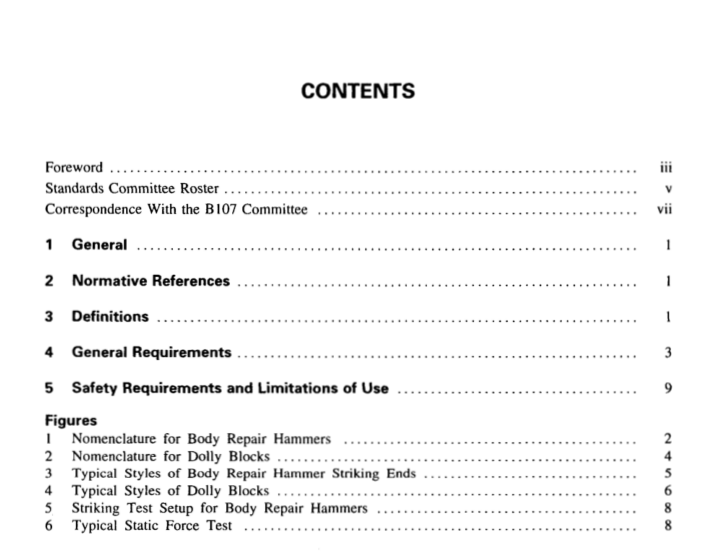ASME B107-56:1999 pdf free download BOOY REPAIR HAMMERS AND DOl l ‘ BLOCKS: SAFETY REQUIREMENTS
3.1 Body Repair Hammers (see Fig. 1 as applicable)
bell:that portion of the hammerhead located betweenthe neck and the striking face.
bumping. dinging. finishing face: the area of the ham-mer used to restore the damaged sheet metal panel toits original shape by striking.
chamfer:the bevel or equivalent radius encircling theperimeter of the striking and struck faces and at theend of cross peens.
cheek:the outside surface of the hammerhead, oneither side of the eye,located between the two necks.eye:an opening or aperture in the hammerhead intowhich the handle is inserted,if the handle is separate.handle: the portion that protrudes from the hammer-head and by which the hammer is held.
neck:the portion of the hammerhead located eitherbetween the bell and the eye or the peen and the eye,or both.
peen:the striking surface of the hammerhead locatedin front of the neck. The peen may have one of thefollowing shapes:
(a) wedge-shaped (as in a cross peen or cross chise1);(b) cylindrical (as in a cylindrical cross peen);
fc) rounded (as in a ball peen).
pick: the elongated tapered portion of the hammerheadextending from the eye to the point.
point: the striking surface located at the end of thepick.
safety message:the information imprinted on or af-fixed to the hammer that is intended to promote safety.shrinaking face: the striking surface that is normallyserrated. It may be flat or crowned.
striking face:the portion of the hammerhead locatedin front of the bell and chamfer that contacts the sheetmetal during use.
striking face crown:the convex shape or radius ofthe striking face.
striking surface: the surface of a hammerhead,peen,or pick intended to contact the sheet metal during use.
struck face: the portion of the hammerhead, exclusiveof the chamfer, that is intended to be struck with astriking tool during use.
3.2 Dolly Blocks (see Fig. 2 as applicable)beading edge: an edge of a dolly block with a roundedapex that is used to raise a bead.
crown:a broad area of the working surface that isconvex in shape.
flanging edge: an edge of a dolly block with anapproximately right-angle rounded surface that is usedto form a flange.
safety message: the information imprinted on or af-fixed to the hammer that is intended to promote safety[see para. 5(k)].
working surface: the portion of the dolly identifiedby its smooth and polished nature.
4 GENERAL REQUIREMENTS
4.1 Design of Body Repair Hammers
Body repair hammers are designed for striking againstsheet metal panels. They shall consist of a hammerheadwith one or more striking surfaces and a handle,orone striking surface and one struck face and a handle,as in a fender bumper.
4.1.1 The hammerhead striking surfaces may consistof,but are not limited to,any combination of thefollowing styles as shown in Fig. 3:
(a)Bumping. Dinging.Finishing Face.Has a smooth,flat, or crowned striking face. The cross-section of thebell may be round or polygonal.
(b)Picking.Pecking End. Has a pointed or roundedtip called a point at the end of a round or polygonalpick. The axis of the pick may be straight or curved.(c)Shrirking Face. Has a serrated striking face,which may be flat or crowned. The cross-section atthe bell may be round or polygonal.
(d) Ball Peen End. Has a smoothly contoured shapethat is approximately hemispherical.
(e) Cross Peen,Cross Chisel End. Has a wedge orchisel-shaped peen oriented at right angles to the axisof the handle.
Cylindrical Cross Peen End. Has a generallycylindrical-shaped striking part whose axis is orientedapproximately at a rightangle to the axis of thehammerhead and handle.
4.1.2 The fender bumper has a striking surface anda struck face. See Fig. 3(e).
4.1.3 The chamfer on the bumping, dinging, finishing,and other striking faces shall be a minimum of 0.010in. (0.25 mm).
4.1.4 Handles shall be of any design includingergonomic,that will withstand the appropriate testsspecified in paras.4.5.3 and 4.5.4.
4.1.5 The head and handle shall be free of nonfunc-tional sharp edges,points,and surface roughness thatcan inflict personal injury when handling the hammer.
4.2 Design of Dolly Blocks
Dolly blocks are designed for straightening, bumping,shrinking,and finishing sheet metal panels.They areintended for use with or without body repair hammers,but shall not be struck directly with a hammer.
4.2.1 Various typical styles of dolly blocks and theirfunctions are listed here (see Fig. 4). The namesgiven are those generally recognized in the body repairindustry. The styles covered by the Standard are notlimited to those named or illustrated.
(a)General Purpose,Crowned. For use on crownedpanels and flat portions of body panels.
(b)General Purpose,Anvil. For various curves andcontours of body, door panels, and deep skirted fenders.
ASME B107-56:1999 pdf free download
